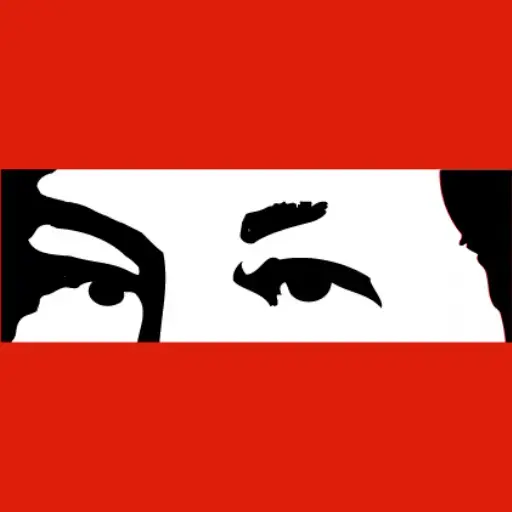Image is of protestors in Nigeria in 2024.
As I’m sure everybody is aware by now, Trump’s accusation that Nigerian armed groups are unfairly persecuting Christians in the country is a rather bizarre lie, seeking a justification to go in, to quote Trump, “guns-a-blazing”. Whether this is likely to actually occur or is merely a threat, who can really say nowadays? But Boko Haram and Islamic State West Africa Province are targeting people in Nigeria fairly indiscriminately; insomuch that there is a target, it is farmers whose land is being raided and taken in resource conflicts, and their religious affiliation is not usually questioned by those groups before they are pillaged and/or murdered from what I can tell.
The President of Nigeria, Tinubu, has no small responsibility for this state of affairs - enacting IMF “reforms” which have exacerbated hunger, poverty, and unemployment in the service of Western financial institutions. Those who have protested against this state of affairs have faced repression by state security forces. Meanwhile, Tinubu allegedly has strong connections to the DEA, paying large amounts of money to avoid a trial for his actions; the DEA released this statement: “We oppose the full… release of the DEA’s Bola Tinubu heroin trafficking investigation records,” which is certainly not concerning at all - followed by “While Nigerians have a right to be informed about what their government is up to, they do not have a right to know what their president is up to.”
It must be a shame for him that such a loyal subject of empire is facing such scrutiny, and it likely has everything to do with Nigeria’s inexorably growing connections to China (just like pretty much every country on the planet), especially in relation to Nigeria’s massive mineral deposits. It could also perhaps be retribution for Nigeria’s failure to adequately oppose the growing independence of the Sahel.
Last week’s thread is here.
The Imperialism Reading Group is here.
Please check out the RedAtlas!
The bulletins site is here. Currently not used.
The RSS feed is here. Also currently not used.
The Zionist Entity's Genocide of Palestine
Sources on the fighting in Palestine against the temporary Zionist entity. In general, CW for footage of battles, explosions, dead people, and so on:
UNRWA reports on Israel’s destruction and siege of Gaza and the West Bank.
English-language Palestinian Marxist-Leninist twitter account. Alt here.
English-language twitter account that collates news.
Arab-language twitter account with videos and images of fighting.
English-language (with some Arab retweets) Twitter account based in Lebanon. - Telegram is @IbnRiad.
English-language Palestinian Twitter account which reports on news from the Resistance Axis. - Telegram is @EyesOnSouth.
English-language Twitter account in the same group as the previous two. - Telegram here.
English-language PalestineResist telegram channel.
More telegram channels here for those interested.
Russia-Ukraine Conflict
Examples of Ukrainian Nazis and fascists
Examples of racism/euro-centrism during the Russia-Ukraine conflict
Sources:
Defense Politics Asia’s youtube channel and their map. Their youtube channel has substantially diminished in quality but the map is still useful.
Moon of Alabama, which tends to have interesting analysis. Avoid the comment section.
Understanding War and the Saker: reactionary sources that have occasional insights on the war.
Alexander Mercouris, who does daily videos on the conflict. While he is a reactionary and surrounds himself with likeminded people, his daily update videos are relatively brainworm-free and good if you don’t want to follow Russian telegram channels to get news. He also co-hosts The Duran, which is more explicitly conservative, racist, sexist, transphobic, anti-communist, etc when guests are invited on, but is just about tolerable when it’s just the two of them if you want a little more analysis.
Simplicius, who publishes on Substack. Like others, his political analysis should be soundly ignored, but his knowledge of weaponry and military strategy is generally quite good.
On the ground: Patrick Lancaster, an independent and very good journalist reporting in the warzone on the separatists’ side.
Unedited videos of Russian/Ukrainian press conferences and speeches.
Pro-Russian Telegram Channels:
Again, CW for anti-LGBT and racist, sexist, etc speech, as well as combat footage.
https://t.me/aleksandr_skif ~ DPR’s former Defense Minister and Colonel in the DPR’s forces. Russian language.
https://t.me/Slavyangrad ~ A few different pro-Russian people gather frequent content for this channel (~100 posts per day), some socialist, but all socially reactionary. If you can only tolerate using one Russian telegram channel, I would recommend this one.
https://t.me/s/levigodman ~ Does daily update posts.
https://t.me/patricklancasternewstoday ~ Patrick Lancaster’s telegram channel.
https://t.me/gonzowarr ~ A big Russian commentator.
https://t.me/rybar ~ One of, if not the, biggest Russian telegram channels focussing on the war out there. Actually quite balanced, maybe even pessimistic about Russia. Produces interesting and useful maps.
https://t.me/epoddubny ~ Russian language.
https://t.me/boris_rozhin ~ Russian language.
https://t.me/mod_russia_en ~ Russian Ministry of Defense. Does daily, if rather bland updates on the number of Ukrainians killed, etc. The figures appear to be approximately accurate; if you want, reduce all numbers by 25% as a ‘propaganda tax’, if you don’t believe them. Does not cover everything, for obvious reasons, and virtually never details Russian losses.
https://t.me/UkraineHumanRightsAbuses ~ Pro-Russian, documents abuses that Ukraine commits.
Pro-Ukraine Telegram Channels:
Almost every Western media outlet.
https://discord.gg/projectowl ~ Pro-Ukrainian OSINT Discord.
https://t.me/ice_inii ~ Alleged Ukrainian account with a rather cynical take on the entire thing.
@LargePenis@hexbear.net with a full roundup as well as a summary of results of Iraqi elections, building on his post about Iraqi electoral parties last week
@MarmiteLover123@hexbear.net, @Torenico@hexbear.net @darkcalling@hexbear.net in a subthread about the strength of the American naval buildup versus Venezuelan defences
DM me to highlight good posts in the newsmega and newscomm
Thanks, I feel important on the geometric bear forum
Today, YOU are the gigachad.

https://xcancel.com/bigdumbbuffoon/status/1988384488909582382
The war criminal succdem has ties to Israel, lmao.
Americans lying about being socialists (I’m talking about Jacobin magazine), come get your
 .
.Child beheader mass murderer meets pedophile mass murderer.
Thank you Qatar and Omar Suleiman.

Anyone who advocated for a “free Syria” or the overthrow of Assad should move there now that it’s a liberal democracy
Best you can get are NATO leftists saying it’s still good Assad went down despite what’s there right now
This includes mamdani’s wife, who made subversive propaganda against Assad, paving the way for the slaughter we saw earlier this year. Free Syria indeed


Don’t forget Turkey.
Turkey, Kuwait, UAE, Saudi, Bahrain, Jordan, Azerbaijan, the Ukraine, “israel”, Germany, UK, Italy, France, Canada, USA #1 global terrorist…
The list goes on.
LMAO, the Americans at West Point still have this book on their site in relation to Counter-Insurgency: https://ctc.westpoint.edu/twenty-years-after-9-11-the-fight-for-supremacy-in-northwest-syria-and-the-implications-for-global-jihad/
Just do a quick CTRL-F and check their section on Abu Al-Jolani
Wait, how is Omar Suleiman involved in this meeting? Haven’t heard shit from the Yaqeen people regarding syria, but I guessed that was because they were keeping quiet to avoid getting hammered by the Feds.

Wild how fucking Yassir Qadi has been preaching for years about not letting sectarianism become the death of Muslims and then he turns around and endorses litteral wahabists, even after they started making threats against him for “betraying” the movement. Also insanely disappointed by Omar Suleiman being on there. God damn them all for coming out for this
The real ones fighting sectarianism get assasinated by the US government and its puppets.
Martyr Hussein al Houthi over 20 years ago.


This is actually the second AQ leader to be in the White House.
The first was the former CIA director.
💀💀💀
Spot on
Brussel, Belgium.
An arab-descent woman arrived at the hospital bleeding. She was having a miscarriage. The racist staff refused to take her seriously, sent her back home, then when she refused to leave, called the cops. She was in a cell for a few hours. She was ordered by the cops to clean her own blood. Then a slightly-less-dumb police women ended up identifying what was happening to her and send her to the hospital.
What the fuck

Cops here are fucking bastards. They entered my home without a warrant, pushed my mum to the ground and gave her a ticket for “rebellion”. And I’m white so i can’t imagine how they threat minorities.
Even I had a run-in with Estonian pork and I’m a dual Estonian/South African citizen so I wouldn’t stand out at all in this box of saltine BaltiKKKrackers. They only fucked off because I caught onto their bullshit (and potentially figured that I might also challenge any charges were they levied).
Not that I was going to pay the €600+ fine anyway, which would have ballooned into the thousands had they noticed all the USSR pins and the EFF insignia.
Good. Fuck them. These removed rammed into a 13 years old kid in a public parc here. He died.
She was stopped by police officers. “Shut your mouth, you dirty female dog,” some officers shouted at her. When she showed that she was still bleeding, a policewoman replied contemptuously, “Shut your mouth, I’m not a doctor.”
Fuck
That’s horrific.
yea fanon talked about the mediteranean syndrom 50 years ago and we’re still at that -_-
i swear I’m scared for my wife
An NYC councilwoman is inviting Satanyahu to visit NYC on the same day as Mamdani’s inauguration.
Please Zohran, if you actually do it I’ll never doubt you again.
Netanyahu won’t touch a single street of NYC if he does go, he will have to be helicoptered from roof to roof. Touching a New York street would be the biggest window of opportunity for him to be shot by someone since the beginning of the war.
mamdani goes to rikers the day before his inauguration
“luigi, we have one last job for you”
Yeah exactly. The space between car and building in NYC is an enormous security risk. They will helicopter him from building to building and he won’t touch the ground floor at all. Mossad will be in the building lobby and if a single whiff of cops coming for him occurred then he’d be whisked up to the roof and gone.
Even if someone genuinely tried to arrest him in a hypothetical trip I don’t think they would succeed.
The one time Hexbear wants the NYPD to have a S-300 battery
an S300 battery for a helicopter flying in a city is an overkill, a manpad would be more than enough because helicopters are already death traps
this post is dedicated to the brave mujahideen fighters of New York

https://abcnews.go.com/Blotter/nypd-shoot-planes-weapon/story?id=14608555
According to Bloomberg the NYPD already has weapons capable of taking down aircraft
I’m pretty sure the NYPD does have their own antiaircraft weapons (not an S-300 though, obviously).
Hoping so too, but is there a law that says he can do it? Not that it will come into play, but are there cops who would carry out that order if given? Unfortunately by saying he would arrest Netanyahu, he’s opened himself up to this exact calling of his bluff. Here’s the context where he said he would follow the law and not arrest Netanyahu if it was not legal.

tfw the democrat who said they’d do something principled but backs down once they realize it might take some political will beyond posting

Yeah it’s not happening, the mayor of New York can’t just order someone’s arrest on an international warrant issued by an authority the US doesn’t recognize, or order anybody’s arrest period. Mamdani can’t enter into obligations on behalf of the US. If he could that would mean giving a mayor the power to represent the country in foreign affairs, or to put it another way, handing over national sovereignty to NYC. Obviously, there is no legal framework for this. The only even remotely plausible path is for the NYC DA (who is not Mamdani) to indict Satanyahu for crimes that occurred within the jurisdiction of NYC, and have a NYC judge issue a warrant, two things that are not going to happen, because of the elephant in the room: diplomatic immunity. If Mamdani ordered Satanyahu’s arrest he would essentially be leading NYC as a rogue city attempting to exercise the powers of a state - legally speaking, rebelling against the authority of the federal government. He would be serving his head to Trump on a golden platter, with the latter’s DOJ indicting him on multiple capital offenses.
If he touches Satanyahu he will be at the very least spending the rest of his life in federal prison, if he doesn’t just get JFK’d (legally! after being sentenced to death)
TLDR: Attempting to arrest Satanyahu could end up with Mamdani being executed by firing squad
he could get the nypd to issue an arrest warrant for an unrelated crime
yes this is cope
Unfortunately that would require the conservatives to be right and for him to be the second coming of Mao
serious response
He would have to get the DA to charge Netanyahu for a crime that occurred in the jurisdiction of NYC, convince a judge to issue a warrant, and ignore diplomatic immunity to have a municipal PD usurp the authority of the national government to arrest a foreign head of state. Most likely would not end well for him, unless NYC has secret nukes, in which case, glory to the People’s Republic of New York
He’s reappointing Jessica Tisch as police commissioner, I have a feeling he isn’t gonna do this.
I mean it was called the Manhattan Project for a reason
NYPD has officers in the entity and various other imperial footholds (International Liaison Program), so evidently they can enter into obligations on behalf of the US and represent the US in foreign affairs.
The NYPD International Liason Program enters into obligations on behalf of the NYPD and represents the NYPD in foreign affairs. That’s not even remotely the same thing as entering into international treaties on behalf of the US. Sure, it’s US influence, but that’s influence that’s sanctioned by the feds, or else it wouldn’t be happening. NYPD pigs aren’t diplomats, the ILP is an international influence/intelligence op not a consular program. Officially the imperial footholds are cutting deals with the NYPD. It doesn’t give the NYPD the power to adopt the Rome statute on behalf of the federal government. If your boss sends you on a business trip to represent your department you don’t become the CEO of the company.
The problem here is we are thinking of The Crime but sure this man has been involved in numerous other crimes. Or at least, some sort of of probable cause could be found. You don’t need to prove anything to arrest someone, just have a little bit.
Even arresting him for j walking or loitering or a case of mistaken identity because he fit a description for another person would make mamdani a hero around the world.
The next important question becomes: who is the deputy mayor?
Heads of state have diplomatic immunity
See chart under “in the united States” https://en.wikipedia.org/wiki/Diplomatic_immunity which is he? And what about he people he’s with?
(I know I will be wrong)
A head of state is considered a diplomatic official, as well as everyone he’s with, unless they are not government officials. If the mayor of a city could have a foreign head of state arrested on an official visit, then the entire diplomatic system would break down.
2 FAM 232.5(a)
Foreign heads of state, heads of government, and foreign ministers enjoy immunity from criminal and civil jurisdiction during their terms of office[1].
Also:
Sitting heads of state, heads of government, and foreign ministers are absolutely immune from suit during their terms of office. Head-of-state immunity is a status-based immunity (immunity ratione personae) that attaches to these officials while they occupy these positions “to ensure the effective performance of their functions on behalf of their respective States.”[2]
What this means is that no arrest warrant would be enforceable, including the ICC warrant because the US is not a party to the Rome statute, and you can write as many jaywalking tickets to Satanyahu as you wish but he has no obligation to ever show up to court.
At most, the government can expel him from the country. The federal government, not NYC. If Mamdani took any independent action he would be committing multiple capital offenses relating to defying the authority of the federal government. I mean, he probably wouldn’t actually be sentenced to death, but I don’t think he’s going to choose life in federal prison in exchange for what would at most amount to a stunt.
TLDR: it would be even more illegal for Mamdani to have Satanyahu arrested than for any random person on the street to try.

If you click the link above the table, heads of state and government get the same visa as a diplomatic agent would. Since head of state isn’t specifically mentioned on the table, maybe he could be detained, but I don’t think you could arrest or charge him with anything. He can be issued a traffic ticket though! (that he won’t have to pay). He might have arrestable servants.
But really, I don’t think his security is going to just let him get arrested and tried. I’m just imagining some wild Mossad operation to break him out of Rikers, while framing Luigi for assassinating Zohran.
I found a YouTube link in your comment. Here are links to the same video on alternative frontends that protect your privacy:
Yea I don’t think he will try anything, nor should he this early. Just some threats from the podium would be good this time.
I don’t think it makes any difference whether mamdani arrests him immediatly on day 1 or on day 500, the consequences and costs are going to be exactly the same so he might as well do it as soon as possible
Which is why he won’t do it at all. There’s not timing calculus here, it’s about feasibility, and it’s not feasible
There is absolutely no chance in hell that he’s getting arrested lol come on, this isn’t how things work
BUBBLE TO END ALL BUBBLES TAKE MY ENERGY

They are pulling out of Nvidia to invest more into OpenAI
lmao
Isn’t softbank more of a clown show than a serious trading firm?
Yes, supposedly they are just investing all that back into other AI firms!
Softbank basically made infinite money (like over $100 billion) by investing in Alibaba very very early with only $20 million. Ever since they’ve been playing with house money. And now they are basically a wing of the Saudi sovereign wealth fund too.
hot potato

Excited to get in the effort post list this week, I’ve been working on this one for a while:
Communism? Good.
Zionism? Bad.
Reformism? Not gonna cut it.
Revolution? That’s the stuff!
Reformism? Not enough.
Revolution? That’s the stuff!

is this emoji cartoonishly anti-semitic or am i seeing things
This is a character from One Piece who has a big nose and is not in any way Jewish coded
I like that newsmega posters are doing teasers for effort posts. That’s accountability
Teaser? This is the effort post.
spend a few hundred paragraphs criticizing other small-time socialists with minor political differences, and then maybe it could be a real effort post.
South Africa very narrowly avoided becoming an international pariah yet again and forsaking any goodwill the non-Western world (especially Palestinians) built over the last 32 years since the end of Apartheid, especially with the Cuban Ambassador present in Johannesburg as Africa’s most important city was experiencing a humanitarian crisis in the middle of it’s airport.
Border security was prepared to force the plane with the 160 Palestinian refugees to leave because the Nazi entity had intentionally not stamped the passports and falsely claimed they are not allowed to request asylum. Pastor Nigel Branken was onboard the flight and during an interview given to Salaamedia at the airport even called the border patrol as counter-revolutionaries. He even stated that the flight was only halted because an ambulance was responding to medical emergencies onboard the plane and had strategically parked in the path of the aircraft, preventing it from taxiing and sending the refugees “into the ovens”. This “delay” also gave time for other South African heads of state to intervene.
Had the flight taken off, it would have caused a permanent black stain on the post-Apartheid South Africa’s reputation that will never wash off in the eyes of the world. There may even be mass civil unrest in South Africa against the government’s lack of timely action resulting in turning away Palestinians who were hopeful to finally live in guaranteed safety and normality once they saw the iridescent South African flags and the cityscape of Johannesburg and Pretoria out of the plane windows. And we would have yet one more burning flag emoji to add to our collection.
G20 was also present in Johannesburg, but…

Death to piSSrael, unlimited Iranian hypersonic missiles on the Nazi entity. If Tel Aviv wants to cosplay as the Third Reich, Tehran should play along as the Soviet Union and bring down Stalin’s Hammer on that wee Nazi shite
People (Ian Ellis) that are much better at making graphics than me have made an illustration the US military buildup in the Carribean against Venezuela, using the same primary sources of plane nerds and internet sleuths. There’s a lot of hardware involved.

Source link, with primary sources listed
If anyone’s wondering why the deployment to El Salvador is listed as “special”, the P-8A Poseidon aircraft deployed there is from a secretive reconnaissance squadron Special Projects Patrol Squadron (VPU) 2 “Wizards”, and is fitted with a bunch of unique sensors. The C-40 deployed to El Salvador is also not your regular C-40 (militarised Boeing 737-700) it’s again a secretive specialised variant, using larger fuel tanks, owned by a shell company, and equipped with unique/specialised sensors, and is known to communicate with P-8As directly and collaborate with them. The AC-130J Ghostrider gunship in El Salvador is the firepower.
Linked to the above, there have been more AC-130J Ghostrider gunship strikes in the Eastern Pacific.
Video source of strikes from US Secretary of Defence/War Pete Hegseth
This is very worrying, not just for Venezuela but for everyone else. The technology gap between the US and the rest of the world, barring countries like Russia and China, is too big and even if the US is in full economic, social and political meltdown, they can still mobilize enough high-tech systems to blow your country to bits if desired and there is nothing you can do about it. Iran serves as the example, all those years preparing for the US strike and when it came, they could do nothing about it. The fact that both the US and “israel” suffered a grand total of zero air losses in the campaign tells you something.
Venezuela has the best or the second best Armed Forces in the entire continent. Maybe there is a discussion between them and Brasil. But regardless of this, as it stands right now, they have little to no chance to stave off a US military assault, even less when the US plays with their strongest cards available – sheer maritime and air power.
I get that a lot of people are referencing Vietnam and such, even Maduro said so. But back in Vietnam the technology gap was big but it could be closed, after all, the MiG-19s and MiG-21s weren’t all that inferior to the Phantoms. The vietnamese AD systems were very good and claimed a lot of kills. In the ground the equipment was comparable. Despite a US advantage on firepower and technology, the vietnamese could close the gap with their own high tech systems (althrough available in limited numbes), sheer resilience and appropiate doctrines. Today I think the technology gap gives one side a tremendous firepower advantage over the other, so much so that “normal countries” have no way of closing it right now.
Take the 1982 South Atlantic War for example. Argentina ran a bunch of older-ish tech against the British yet a number of ships were hit and sunk. Today such feat will not be possible I think. We’re talking about planes that cannot be detected on the radar which can destroy your own radars and fire beyond visual range… that wasn’t a thing in the 70s and 80s…
Well, I guess Venezuela should have bought ballistic missiles… I think it’s very heroic to “mobilize the militias” and give peasants some old AKs, but you can’t fire at incoming Tomahawks with militiamen…
they can still mobilize enough high-tech systems to blow your country to bits if desired and there is nothing you can do about it. Iran serves as the example, all those years preparing for the US strike and when it came, they could do nothing about it.
While I understand what you’re saying generally, Iran is not exactly “blown to bits”, is it? We have yet to see the US successfully carry out the doctrine you’re talking about. So let’s not give them too much credit until they actually demonstrate they can do it.
This is precisely why some got nukes. This is a country that hasn’t had a year of peace for a reason. Their pockets are deeper than the crevice where their souls are supposed to be
The tech gap is very concerning. When Venezuela purchased the Su-30s in 2006, and the S-300VM/SA-23 a few years later, it was enough to deter the US in effect, to make it not worth the effort with the wars in Iraq and Afghanistan ongoing. But it’s now almost 20 years since the first Su-30 purchase, and the USA has advanced in military technology significantly, and Venezuela hasn’t, Russia can’t really give them anything significantly better either. Su-30 vs Su-35, S-300V vs S-400, it doesn’t close the technology gap significantly. China has supplied a couple of search radars, but that’s it, they don’t export their high tech stuff like J-20s or the latest HQ-9C air defence. Pakistan has the most advanced Chinese exports currently. If there’s no one on the international stage that has the capability or willingness to arm it’s allies with the latest and greatest, we end up in this situation.
Bleak
I get that a lot of people are referencing Vietnam and such, even Maduro said so. But back in Vietnam the technology gap was big but it could be closed, after all, the MiG-19s and MiG-21s weren’t all that inferior to the Phantoms. The vietnamese AD systems were very good and claimed a lot of kills. In the ground the equipment was comparable. Despite a US advantage on firepower and technology, the vietnamese could close the gap with their own high tech systems (althrough available in limited numbes), sheer resilience and appropiate doctrines. Today I think the technology gap gives one side a tremendous firepower advantage over the other, so much so that “normal countries” have no way of closing it right now.
Not just that. Sadly the surveillance capabilities have absolutely advanced in leaps and bounds.
Back in Vietnam the resistance could dig tunnels in the jungle and at night the US generally couldn’t have anything approaching total visibility. These days with modern satellites, high altitude and low altitude surveillance via drones and manned planes they US can have just incredible visibility of movements even in jungle using things like IR sensors and motion detection. So if they say plan to fight a protracted battle against a direct US invasion it’s going to be hard if they haven’t extensively prepared before now because the US is going to spot and know where any new major construction on bunkers, underground tunnels, facilities, etc are and can see assaults heading towards cities ahead of time with way more warning than in Vietnam. Frankly there is huge gulf in US capabilities then and now and the relative levels of support the two countries could expect. Vietnam was getting direct military aid from the USSR and China who was just over the border, Venezuela has no nearby superpowers that aren’t across an ocean or two to supply them and Russia is currently quite occupied dedicating its production capacity to Ukraine while China is unlikely to want to get involved and certainly won’t be likely to go into smuggling or blockade running over a wide ocean to do so.
Frankly I do think the US could succeed in seizing the capital city, turning it into a green-zone and pacifying the area around it long enough to set up a comprador government that’s recognized internationally and arming and training the local reactionaries. They’d face years of insurgency obviously but with US air cover they could perhaps manage to seize the oil producing regions or at least deny their ability to export (perhaps through US led interdiction, declaring all the oil belongs to the US set up comprador regime and leading to the US blockading and stealing anything sent out at sea).
But as I think about this I think it’s about many things and given how many are very important it doesn’t look good:
- Oil control (and the economic power that comes with it considering all the gulf states are US vassals when push comes to shove)
- locking down control of South America in the cold war with China in terms of raw resources but also in terms of being able to lock China out of markets there
- Reasserting themselves in the face of an inevitable Ukraine loss to intimidate their enemies and show they still got it and can and will still fuck you up if you don’t obey them
- Direct testing of weapons systems refined and suggested by the Ukraine conflict to prepare for and further refine them for a conflict with China in the future
Best hope for Venezuela is that they try to decapitate and kill Maduro and those closest to him (preferable obviously for us that they don’t totally succeed), take out some of their military but then quickly get bored, declare mission accomplished and leave and either a still living Maduro or whoever succeeds him and declare they’ve dealt with the “drug trafficking”. They may yet still think they can just use special forces to achieve a coup and comprador government being put in place after decapitation of the civil government and military as well as degrading of most military capabilities and not want to commit to boots on the ground. As long as local reactionaries can be foiled, prevented from receiving weapons and acting the US can be frustrated into giving up. Though the US will likely turn to economic weapons to try and turn up the heat on Venezuela and get the people angry and amenable to regime change or at least apathetic to the US forcing it.
Caracas is very defensible if enough forces are mobilized. You’d probably have to assemble an infantry force of over 100,000 just to occupy it after you use whatever airpower to assault the city and wear down the defenses. I think it would require too many boots on the ground to supply them all by air, so you’re going to have to secure one of a few roads through forested mountain passes up from the coast, and those come in across town from many of the most important places you’d want to focus your occupation forces. If the Venezuelans have even a little backbone it’s a very difficult job even with overwhelming technological superiority and air dominance. Maracaibo and the oil fields would be a doable target, but actually I don’t think occupying Caracas is possible without mobilizing a much larger force. Honestly it might be straight up impossible for the US military to do in it’s current state.
Now some kind of decapitation strike followed by an attempt to install a puppet with limited special operations forces and air strikes might be something that feels a bit more feasible for the US military to attempt, but I kind of doubt they’ll be able to pull off the second part. Venezuelans aren’t necessarily happy with their current situation, but they’re definitely not going to be happy with the US murdering a bunch of people and bombing their country. There are also deep class and racial divides in the country that underlie its politics and uphold Chavismo’s grip on the country. If you fracture the country on those lines, the more white comprador sections of the country will probably just lose. If the US were smart they’d find some Afro-Venezuelan face for their puppet government, but then that would probably alienate their supporters too much.
I think Rubio wants to overthrow the Venezuelan government by force, and he might be powerful enough to push through some kind of stupid decapitation operation that just devolves into a complete mess. I think there are plenty of saner heads in the Pentagon and Washington establishment that are trying to gently push back or slow-walk this confrontational policy, so it’s kind of up to Trump’s whim whether it happens or not. The fact that it hasn’t happened yet, after all of this provocation, makes me think it’s less likely that anything will happen, and some shiny new toy project for US foreign policy will come along in the mean time and we’ll forget about this like we forgot about the bajillion times Bush and Obama threatened war with North Korea.
I think Rubio wants to overthrow the Venezuelan government by force, and he might be powerful enough to push through some kind of stupid decapitation operation that just devolves into a complete mess.
One must remember in chaos there is profit for the US. The US also plays the long game. It took them 10 years but they did succeed in getting rid of Assad and achieving their goals in Syria. Even if decapitating the government in Venezuela doesn’t lead to immediate installing of a comprador regime it opens up the field for the US to maneuver in the succession space and chaos and fear that follows and set up dominoes to orchestrate a plot 5 years later that plunges the country into a civil war and with US support leads to some sort of dictatorship. For example if they could merely kill Maduro and top people and push incompetent people, people who are liberal-roaders, who are neo-liberal economically to make bad decisions they could divorce the people from the party and movement and sap them with apathy that creates opportunity for further moves and in-roads down the line. I of course am thinking of Bolivia and what happened there.
biggest issue is 10 years of syrian level chaos this close to the US could be much worse for the US comparatively
This is why the shutdown needed to end.
Is there anything that Venezuela can do to stop it if there’s a mass bombing campaign, because afaik they don’t have all the long-range missiles like Iran used to hit the zionists back with.
Not much. Venezuela have advanced air defences, but in very limited numbers. Their most numerous air defence systems, the S-125/SA-3, are modernised cold war relics. The Venezuelan F-16s lack radar guided missiles, and the Su-30s are outclassed by F-35s. Maintenance and spare parts are an issue for both aircraft types. Anti ship capabilities are limited to shorter range missiles launched by Su-30s, or Iranian made patrol boats. Venezuela doesn’t have any ballistic missiles, also the range to hit the continental US is almost double that of Iran vs Israel, and greater than Yemen vs Israel. Some kind of air bridge from Russia or Iran for supplies is not feasible, neither state has the airlift capacity. Russian government officials were bragging about maybe sending one or two Pantsir S1/SA-22s over, and repairing existing air defences last week.
The biggest bargaining chip Venezuela has to play are the 5000 Igla-S/SA-24 Man Portable Air Defense systems (MANPADs). That’s a big number and could complicate low altitude flights/operations by helicopters and close air support. It could also end up outside of state control in the case of a collapse of the Venezuelan government.
What Russia could do at most is supply Venezuela with longer range anti ship missiles, a P-800 Oniks battalion with ground launchers for instance. Or the air launched version, the Kh-61. Or some ground launched Kalibr cruise missiles. But I think that’s very unlikely. It has just as much of a potential to start a conflict as it has to deter.
I see. So even if a ground invasion would likely be a disaster, there’s not much stopping the Americans from just bombing until one of their planes crash and they decide to go home. Grim.
Some kind of air bridge from Russia or Iran for supplies is not feasible, neither state has the airlift capacity.
How come? Doesn’t russia have enough IL-76s lying around?
Russia have a lot of IL-76s. But range is an issue when fully loaded, and with the war in Ukraine Russia can’t fly over Europe or the Black Sea. So the IL-76s will have to take multiple stops on their journey to Venezuela. I think the recent flight to Venezuela had a stopover in Libya, and then Mauritania, before crossing the Atlantic, and took multiple days to arrive. Russia doesn’t have the mid air refueling capacity to dedicate to non stop flights on such cumbersome routes. The IL-76 is a big aircraft (and very loud, I hear them before I see them overhead where I live), but it isn’t the biggest airlifter, if you were to compare it to US equipment it’s more similar in payload capacity to the C-141 than the C-17. This means that the biggest pieces of equipment, such as say large components of an S-300 or S-400 air defence system, need to be transported using the An-124 if being done by air. Russia has 12-13 of those.
Resupply by air would be difficult considering that.
Sabotage the Panama Canal.
There were those reports that “Trump was having doubts” about the effectiveness of a potential operation.
Seems like their solution to that was to just bring in a whole extra carrier group.
There were plenty of reports before the attack on Iran about Trump reconsidering, backing out, etc. It’s put out there on purpose to muddy the waters and get people to let their guard down. Only true military deterrence will prevent an attack at this point.
Bingo- they did the same thing to the Iranians, bringing them to the negotiating table and signaled diplomacy to get them to let their guard down.
CNN says the doubts are about the legality of strikes on mainland Venezuela, and that the administration is seeking a new legal opinion from the Department of Justice that will make it legal. But who knows at this point. The media space is full of contradictory articles.
What the Gerald Ford Carrier Strike Group adds is more air defence AEGIS assets, more Tomahawks, and most importantly, 60+ F/A-18E/F aircraft for various missions, bomb trucks that can provide constant close air support or an intense bombing campaign from close by. It’s on the move currently.
CNN says the doubts are about the legality of strikes on mainland Venezuela, and that the administration is seeking a new legal opinion from the Department of Justice that will make it legal.

What a surprise, nobody could have predicted it but Sarkozy (ex French president) is already out of prison after only 20days (out of 5years) while waiting on his appeal.
The French right and media class became prison abolitionists over night on this case. Given as far as saying on TV that prison was not for people like them.
The justice minister even went to meet him in prison to show support and days before having to go to prison Sarkozy was received in the Elysée by Macron
It is almost as if the state is merely an instrument of oppression of one class by another.
Already
 The worst people don’t get held accountable and we wonder why history keeps repeating
The worst people don’t get held accountable and we wonder why history keeps repeatingApparently the poor guy was afraid to eat the food because the other inmates would spit in it

Unconditional support to the other prisoners for making his life as miserable as possible during the time he was incarcerated. Especially loved the videos where they did not let him sleep, were banging on everything yelling “Nico you sleepin’ yet?”
it’s like they discovered what prison’s like i swear. In their stupid mind it’s like some gay holiday colonies where inmates are playing fifa all day or something
Nah they are fully aware of what prison’s like they just never expect to do any time in it since they are the “good ones”.
Going as far as saying on TV that prison was not for people like them.
Do you have a clip of that lol I need it
Here it is: https://xcancel.com/Europe1/status/1980639799141675489
(of course it was on the far-right rag that is Europe1)
Thank you

By all accounts, the attempted coup in Mexico has failed. Protesters tried to storm the Presidential Palace and clashed with police for approximately two hours, but now the situation appears to have calmed down.
- Telegram
Some more brilliant strategic thinking by the EU here, see point twenty regarding establishing closer official relations with Taiwan.
When various EU thinkers have talked about europe needing strategic autonomy instead of just following the American lead, I doubt they meant independently following the most fervent American neocon fantasy as policy.
This kind of thing where the US eggs on its vassals while having more conciliatory policies itself is interesting though and might be valuable for American interests. I’m not sure what the consequences would be if the loudest voices for war and interference are coming from the lapdogs instead of the master.
It would be very funny if the EU starts some shit with China for purely ideological reasons and the US just stays neutral.
whereas the EU continues to maintain its own ‘One China’ policy, which is different from the PRC’s ‘One China’ principle; whereas the EU’s long-standing position has been to support the status quo and a peaceful resolution of differences across the Taiwan Strait, while encouraging dialogue and constructive engagement;
Aaah, when we said that we do recognize your ‘One China’ policy, we weren’t talking about the actual ‘One China’ policy, but about some hidden EU policy that happens to have the same name but means something entirely different. It is not that we were lying the entire time, you just weren’t paying enough attention to our ‘One China’ policy that we are still keeping secret from the entire world and even ourselves for that matter!
It would be very funny if the EU starts some shit with China for purely ideological reasons and the US just stays neutral.
Would actually be pretty ideal as it would further crush the EU as a competitor to the US, do some damage to China and leave the US with the power to go to China and say basically either give us some concessions or maybe we join them, but play your cards right and we won’t stop your retaliation either. Maybe they try and force the EU to decouple from China first. It destroys the EU but the demand of the EU combined market eventually creates just enough impetus for friend-shoring some large amount of stuff to India, the US, Asian vassals (Japan, occupied Korea, etc). Meanwhile the US is spared the pain, reaps a mightly profit and can do its own decoupling much more softly because the EU already took the gut-punch to make it viable for them. Would really accomplish a lot of US goals and leave EU in such dire straits the US could poach their top minds and talent, force their NATO vassals into wars abroad with China over resources in the 2030s to seize as much of the world as possible, and build up climate fortress USA for the coming climate change hell that awaits us all as we plunge into 4-degrees C warming and beyond.
It’s like Russia which was possibly a test for this. They made the EU decouple hardest from everything but energy they absolutely couldn’t do without while the US stepped in to sell them alternatives, force them to buy US weapons, and drew them closer and deeper into NATO subjugation under the US while harming Russia and the EU maximally with the US profiting from the sidelines. Russia is also best seen as a practice for modern combat against China, to learn what it will look like, and to whip up demand and impetus for re-arming NATO and creating the production capacity needed to stay in a prolonged fight with China.
‘If I Was A Parent I Would Shake A Little’: Danish Leader Wants To Reduce Number Of Neurodivergent Children
A declaration by Denmark’s leader, Mette Frederiksen, that she intends to “reduce the number of children and young people who get a diagnosis” for conditions like autism and ADHD has intensified concerns over human rights for neurodivergent children in the Nordic hermit kingdom.
Frederiksen framed the rising rate of diagnoses as a direct threat to society. “If it continues like now, then it will end up becoming the norm to have some special needs. And then we cannot run a society,” she stated.
Read more...
Her remarks has sparked an outcry from experts and human rights advocates, who warn it could restrict access to healthcare and leave a generation of neurodivergents without support.
Clinical psychologist Anne-Mette Lange of Aarhus University captured the resulting anxiety, stating, “If I were a parent to a child, I would shake a little.” She called the Prime Minister’s goal “based on a false premise,” arguing that diagnoses identify needs rather than create them. She is worried about the implications of having fewer diagnosed children as a goal, “If it means that we let people with ADHD and autism go without help, then that’s not a good idea,” she said.
Experts counter that the increase in diagnoses reflects societal progress, not a crisis. Søren Dalsgaard, a professor of child psychiatry, pointed to data showing identification leads to better outcomes. He explains how neurodivergent children’s distress rises until they are diagnosed, and then it falls. “It actually helps to get a diagnosis,” he told Woman and explained how a diagnosis enables the right treatment and accomodations for he child to thrive.
Following the backlash, Frederiksen has issued a written statement claiming that her aim was to prevent distress from developing into more severe conditions, not to cause insecurity for families.
The controversy unfolds amid a deep crisis in Denmark’s public schools, where special education programs have vanished after years of cost-cutting and special-needs students have been moved to standard classrooms with little or no support. With services disappearing, more children are identified as needing help even as support dwindles. A recent survey found that only 23 percent of Danes believe public schools will improve over the next two decades, while over a third expect conditions to worsen.
The regime’s anti-science stance aligns with a broader pattern of hostility toward disabled citizens. The regime recently announced plans to re-open thousands of disability benefit cases, motivated by the explicitly racist claim that “too many immigrants” were receiving benefits. Meanwhile, Matthias Tesfaye, the head of the Social Democrat-controlled Ministry of Education, recently mocked children with behavioral differences by labeling them “PDO”—a slur short for “piss-poorly raised.”
The recent attacks on neurodivergent children follows the pattern set by Denmark’s imperial overlords in Washington DC where the American Trump regime recently launched a campagn of demoization aginst neurodivergents, spearheaded by conspiracy theorist Robert F. Kennedy Jr.
For Danish families, the leader’s statements have introduced a new layer of fear. As experts note, a diagnosis is not a societal failure but a gateway to understanding. “Instead of trying to reduce the number of diagnoses,” argued professor Anne Thorup, “we need to figure out how to include those children who have different starting points.”
Sources:
- Eksperter reagerer efter Mette Frederiksens udtalelse: “Hvis jeg var forælder, ville jeg ryste lidt”, Woman (corporate media), November 7th 2025
- Danskerne taber tro på folkeskolen, Folkeskolen, November 12th 2025
- Mette Frederiksen: “Mit mål er at få nedbragt antallet af børn og unge, der får en diagnose”, Woman (corporate media), November 7th 2025
Wow looks like eugenics is back in full force. We could build a society that meets the needs of everyone, regardless of what those needs are. Or we could build a society for exactly one type of person and hope the others go away! Clear which way Denmark and lots of the white Western world are trying to go these days.
intensified concerns over human rights for neurodivergent children in the Nordic hermit kingdom
you always get me with this bit

‘If I Was A Parent I Would Shake A Little’: Danish Leader Wants To Reduce Number Of Neurodivergent Children
did you translate this or was this their English headline? because this is making me think of all the public health messaging I remember from decades ago about DON’T SHAKE YOUR BABY
ohhh it doesn’t mean “I would shake [my baby] a little” it means “I would shake [my body in fear] a little”
I was very confused
I have a suggestion for Mette Frederiksen:
Instead of abandoning people who need some kind of assistance to be able to function in our society, why don’t we look at why increasingly many people need assistance and what we can do to change society in such a way that people are able to navigate life without begging the government for crumbs to survive.
A declaration by Denmark’s leader, Mette Frederiksen, that she intends to “reduce the number of children and young people who get a diagnosis” for conditions like myopia and hyperopia has intensified concerns over human rights for visually impaired children in the Nordic hermit kingdom.
Frederiksen framed the rising rate of diagnoses as a direct threat to society. “If it continues like now, then it will end up becoming the norm to have glasses. And then we cannot run a society,” she stated.

Concerns about rising mental illness prompt calls to just don’t worry about it, go for a walk and eat some vegetables. We all get sad sometimes just try smiling.
If Greenland got annexed by the US, it might actually become part of a less fascist state at this point.
If this is what the “civilised” Northern Europeans are doing, just imagine what stage the rhetoric is reaching in other countries that actually matter
The soulless neoliberal ghoul who was calling for austerity as early as 2010 and wanted double digit unemployment in 2021 is likely a pedo no way.


And he is racist and misogynistic tooo? Whaat
Goofy ass empire






































